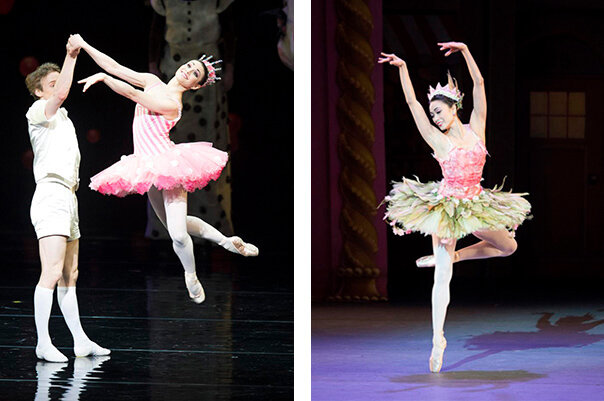The Orange County Register
New ballet 'Whipped Cream' is weird and wonderful in Costa Mesa
By: Paul Hodgins - Staff Writer – March 16, 2017
Photos by Matt Masin, Orange County Register, SCNG
There were many reasons to drive dance fans giggly with excitement over American Ballet Theatre's "Whipped Cream," which was introduced to the world on Wednesday night at Segerstrom Hall.
Orange County was hosting a world premiere of the full-length ballet by the company's celebrated choreographer, Alexei Ratmansky. ABT favorite David Hallberg was appearing in a major role after being sidelined by an injury for 2 1/2 years. And the Segerstrom Center for the Arts, one of America's greatest dance presenters since it opened its doors in 1986, helped underwrite "Whipped Cream," shouldering part of its reported $3 million price tag.
But the man who stole the show on Wednesday wasn't a dancer or choreographer. When the ecstatic ovations washed over the performers and creators as they took their bows, set and costume designer Mark Ryden got the biggest whoops and whistles.
The adulation was both well deserved and remarkable: "Whipped Cream" is Ryden's first theatrical credit.
Ryden is well known in the art world for his iconoclastic and haunting work, which combines the totems of childhood - bunnies and other cuddly creatures, often colored pink or blue - with more disturbing and confounding things: images of Lincoln and Colonel Sanders, bees, misshapen people, animalistic trees and flowers.
A sense of the fantastical and a touch of the sinister are crucial to "Whipped Cream." The music is by Richard Strauss, composed for "Schlagobers," one of only two scores he wrote for ballet. Choreographed by little-known Heinrich Kröller, it bombed at its June 1924 premiere at the Vienna State Opera, where Strauss was co-director.
Ratmansky used the original's playful story about a boy who becomes ill at a candy shop and ends up in a creepy hospital. But he deliberately avoided researching the details of the 1924 version. Instead, he worked closely with Ryden, who was clearly given free rein to explore the story's possibilities.
The result is astounding. Ryden has concocted a Dr. Seuss-meets-Salvador Dali world full of delight and wonder, humor and mystery, with an occasional whiff of weirdness and menace.
"Whipped Cream" begins with a spectacular visual display - one of many gasp-inducing tableaus. A horse-drawn wagon waits outside a church, where a group of children take their first communion. The pink horse is a cartoonish, endearing creation animated by hidden performers. The adults, here and throughout the story, are portrayed by dancers who wear gigantic false heads, making them seem authoritative yet remote. The children are dressed in white, the color of innocence.
At the sweet shop, one rambunctious boy (Daniil Simkin, a master of youthful roles) overindulges in his favorite food, whipped cream. Felled by a tummy ache, he is carted away to a hospital.
After the kids leave, the empty shop plays host to an army of Fellini-esque creatures who display some sharp parade-square moves: marzipan archers, sugarplums with spears, delicious-looking gingerbread men. Then the soloists pop out of their appropriate boxes on the confectioner's shelf: Princess Tea Flower (Stella Abrera), Prince Coffee (Hallberg), Prince Cocoa (delightfully hammy Joseph Gorak) and Don Zucchero (Blaine Hoven). They vie for her affection, and Coffee prevails. Hallberg and Abrera dance a delicate, deceptively challenging pas de deux.
Meanwhile, the boy wakes in his hospital bed, where he's attended by a foreboding-looking old doctor (Alexei Agoudine) and an army of nurses carrying huge needles. A gigantic, disembodied eye hovers over the scene. After a terrifying bout of injections, the doctor and his entourage indulge in a round or two of drinks, passing out and allowing the boy to escape. He is whisked away by Princess Praline to her kingdom, where a menagerie of creatures great and small is partying. Above the hoedown, Lincoln and a bouncing bee watch impassively.
The story ends with bravura solo displays, a coronation, a snake-person, some huge, cuddly creatures with sweet yet strangely unsettling faces... really, all powers of description fail at this point. You have to see "Whipped Cream" yourself to appreciate the giddy, grandiose weirdness of it all.
This slight ballet won't appeal to those who demand seriousness and memorable dancing from their ballets. Ratmansky's choreography and the performances dutifully serve the mood and look of the whole. As with Christopher Wheeldon's "Alice's Adventure in Wonderland," you have to surrender to whimsy and artifice and be childlike again.
If you can submit to those terms, you'll love what has been created. And you'll come away hoping that "Whipped Cream" is just the beginning of Ryden's relationship with ABT and the world of dance.












